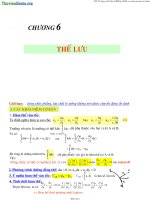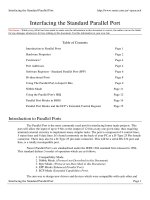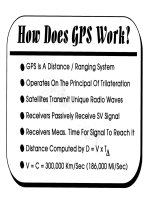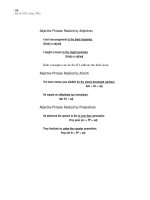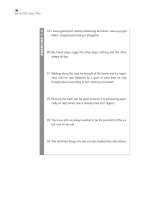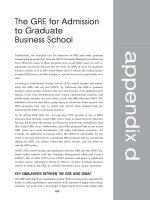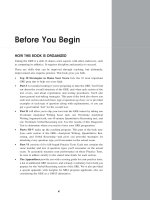Tài liệu 42 The Perceptual Audio Coder (PAC) pptx
Bạn đang xem bản rút gọn của tài liệu. Xem và tải ngay bản đầy đủ của tài liệu tại đây (196.7 KB, 20 trang )
Deepen Sinha, et. Al. “The Perceptual Audio Coder (PAC).”
2000 CRC Press LLC. <>.
ThePerceptualAudioCoder(PAC)
DeepenSinha
BellLaboratories
LucentTechnologies
JamesD.Johnston
AT&TResearchLabs
SeanDorward
BellLaboratories
LucentTechnologies
SchuylerR.Quackenbush
AT&TResearchLabs
42.1Introduction
42.2ApplicationsandTestResults
42.3PerceptualCoding
PACStructure
•
ThePACFilterbank
•
TheEPACFilterbank
andStructure
•
PerceptualModeling
•
MSvs.LRSwitching
•
NoiseAllocation
•
NoiselessCompression
42.4MultichannelPAC
FilterbankandPsychoacousticModel
•
TheCompositeCoding
Methods
•
UseofaGlobalMaskingThreshold
42.5BitstreamFormatter
42.6DecoderComplexity
42.7Conclusions
References
PACisaperceptualaudiocoderthatisflexibleinformatandbitrate,andprovideshigh-
qualityaudiocompressionoveravarietyofformatsfrom16kb/sforamonophonic
channelto1024kb/sfora5.1formatwithfourorsixauxiliaryaudiochannels,and
provisionsforanancillary(fixedrate)andauxiliary(variablerate)sidedatachannel.
Inallofitsformsitprovidesefficientcompressionofhigh-qualityaudio.Forstereo
audiosignals,itprovidesnearcompactdisk(CD)qualityatabout56to64kb/s,with
transparentcodingatbitratesapproaching128kb/s.
PAChasbeentestedbothinternallyandexternallybyvariousorganizations.Inthe1993
ISO-MPEG-25-channeltest,PACdemonstratedthebestdecodedaudiosignalquality
availablefromanyalgorithmat320kb/s,faroutperformingallalgorithms,includingthe
layerIIandlayerIIIbackwardcompatiblealgorithms.PACistheaudiocoderinmost
ofthesubmissionstotheU.S.DigitalAudioRadio(DAR)standardizationproject,atbit
ratesof160kb/sor128kb/sfortwo-channelaudiocompression.Ithasbeenadaptedby
variousvendorsforthedeliveryofhighqualitymusicovertheInternetaswellasISDN
links.OvertheyearsPAChasevolvedconsiderably.Inthispaperwepresentanoverview
forthePACalgorithmincludingsomerecentlyintroducedfeaturessuchastheuseofa
signaladaptiveswitchedfilterbankforefficientencodingofnon-stationarysignals.
42.1 Introduction
Withtheoverwhelmingsuccessofthecompactdisc(CD)intheconsumeraudiomarketplace,the
public’snotionof“highqualityaudio”hasbecomesynonymouswith“compactdiscquality”.The
CDrepresentsstereoaudioatadatarateof1.4112Mbps(megabitspersecond).Despitecontinued
c
1999byCRCPressLLC
growth in the capacity of storage and transmission systems, many new audio and multi-media
applications require a lower data rate.
In compression of audio mater ial, human perception plays a key role. The reason for this is
that source coding, a method used very successfully in speech signal compression, does not work
nearly as well for music. Recent U.S. and international audio standards work (HDTV, DAB, MPEG-
1, MPEG-2, CCIR) therefore has centered on a class of audio compression algorithms known as
perceptual coders. Rather than minimizing analytic measures of distortion, such as signal-to-noise
ratio, perceptual coders attempt to minimize perceived distortion. Implicit in this approach is the
idea that signal fidelity perceived by humans isabetter quality measure than “fidelity” computed by
traditional distortion measures. Perceptual coders define “compact disc quality” to mean “listener
indistinguishable from compact disc audio” rather than “two channel of 16-bit audio sampled at
44.1 kHz”.
PAC,thePerceptualAudioCoder [10],employs sourcecoding techniquesto removesignalredun-
dancy and perceptual coding te chniques to remove signal irrelevancy. Combined, these methods
yield a high compression ratio while ensuring maximal quality in the decoded signals. The result is
a high quality, high compression ratio coding algorithm for audio signals. PAC provides a 20 Hz to
20 kHz signal bandwidth and codes monophonic, stereophonic, and multichannel audio. Even for
the most difficult audio material it achieves approximately ten to one compression while rendering
the compressioneffectsinaudible. Significantly higher level ofcompression, e.g.,22to 1, isachieved
with only a little loss in quality.
The PAC algorithmhasits rootsina studydonebyJohnston [7,8]onthe perceptualentropy(PE)
vs. the statistical entropy of music. Exploiting the fact that the perceptual entropy (the entropy of
that portion of the music signal above the masking threshold) was less than the statistical entropy
resulted in the perceptual transform coder (PXFM) [8, 16]. This algorithm used a 2048 point real
FFT with 1/16 overlap, which gave good frequency resolution (for redundancy removal) but had
some coding loss due to the window overlap.
The next-generation algorithm was ASPEC [2], which used the modified discrete-cosine trans-
form (MDCT) filterbank [15] instead of the FFT, and a more elaborate bit allocation and buffer
control mechanism as a means of generating constant-rate output. The MDCT is a critically sam-
pled filterbank, and so does not suffer the 1/16 overlap loss that the PXFM coder did. In addition,
ASPEC employed an adaptive window size of 1024 or 256 to control noise spreading resulting from
quantization. However, itsfrequencyresolution washalf thatof PXFM’sresultingin someloss inthe
coding efficiency (c.f., Section 42.3).
PACasfirstproposedin[10] is a third-generation algorithm learning from ASPEC and PXFM-
Stereo [9]. In its current form, it uses a long transform window size of 2048 for better redundancy
removaltogetherwithwindowswitchingfornoisespreadingcontrol. Itaddscompositestereocoding
in a flexible and easily controlled form, and introduces improvements in noiseless compression and
threshold calculation methods as well. Additional threshold calculations are made for stereo signals
to eliminate the problem of binaural noise unmasking.
PAC supports encoders of varying complexity and quality. Broadly speaking, PAC consists of a
core codec augmented by various enhancement. The full capability algorithm is sometimes also
referred t o a s Enhanced PAC (or EPAC). EPAC is easily configurable to (de)activate some or all of
the enhancements depending on the computational budget. It also provides a built-in scheduling
mechanism so that some of theenhancements are automatically turned on oroffbasedon averaged
short term computational requirement.
One of the major enhancements in the EPAC codec is geared towards improving the quality at
lower bit rates of signals with sharp attacks (e.g., castanets, triangles, drums, etc.). Distortion of
attacks is a particularly noticeable artifact at lower bit rates. In EPAC, a signal adaptive switched
filterbank which switches between a MDCT and a wavelet transform is employed for analysis and
synthesis [18]. Wavelet transform offer natural advantages for the encoding of transient signals and
c
1999 by CRC Press LLC
the switched filterbank scheme allows EPAC to merge this advantage with the advantages of MDCT
for stationar y audio segments.
Real-time PAC encoder and decoder hardware have been provided to standards bodies, as well
as business partners. Software implementation of real time decoder algorithm is available on PCs
and workstations, as well as low cost general-pur pose DSPs, making it suitable for mass-market
applications. The decoder typically consumes only a fraction of the CPU processing time (even
on a 486-PC). Sophisticated encoders run on current workstations and RISC-PCs; simpler real-
time encoders that provide moderate compression or quality are realizable on correspondingly less
inexpensive hardware.
In the remainder of this paper we present a detailed overview of the various elements of PACs, its
applications, audio quality, and complexity issues. The organization of the chapter is as follows. In
Section42.2,someofapplicationsofPACanditsperformanceonformalizedaudioqualityevaluation
tests is discussed. In Section 42.3, we begin with a look at the defining blocks ofaperceptual coding
scheme followed by the description of the PAC structure and its key components (i.e., filterbank,
perceptual model, stereo threshold, noise allocation, etc.). In this context we also describe the
switched MDCT/wavelet filterbank scheme employed in the EPAC codec. Section 42.4 focuses on
the multichannel version of PAC. Discussions on bitstream formation and decoder complexity are
presented in Sections 42.5 and 42.6, respectively, followed by concluding remarks in Section 42.7.
42.2 Applications and Test Results
In the most recent test of audio quality [4] PAC was shown to be the best available audio quality
choice [4] for audiocompression applications concerning 5-channelaudio. This testevaluatedboth
backwardcompatibleaudio coders(MPEGLayerII,MPEGLayerIII)andnon-backwardcompatible
coders, includingPAC.Theresults ofthese tests showed thatPAC’s performancefarexceeded thatof
the next best coder in the test.
Among the emerging applications of PAC audio compression technology, the Internet offers one
of the best opportunities. High quality audio on demand is increasingly popular and promises both
to make existing Internet services more compelling as well as open avenues for new services. Since
most Internet users connecttothenetwork using as low bandwidth modem (14.4to28.8kb/s) or at
best an ISDN link, high quality low bit r ate compression is essential to make audio streaming (i.e.,
realtime playback)applications feasible. PAC isparticularlysuitable forsuchapplicationsasit offers
nearCDqualitystereosoundattheISDNratesandtheaudioqualitycontinuestobereasonablygood
for bit rates as low as 12 to 16 kb/s. PAC is therefore finding increasing acceptance in the Internet
world.
Another application currently in the process of standardization is digital audio radio (DAR). In
the U.S. this may have one of several realizations: a terrestrial broadcast in the existing FM band,
with the digital audio available as an adjunct to the FM signal and transmitted either coincident
with the analogFM,or in an adjacenttransmission slot; alternatively, it canbea direct broadcastvia
satellite(DBS),providing acommercial music service inan entirelynewtransmission band. In each
of theabovepotentialservices,AT&T andLucent Technologies haveenteredorpartnered withother
companies or agencies, providing PAC audio compression at a stereo coding rate of 128 to 160 kb/s
as the audio compression algorithm proposed for that service.
Some other applications where PAC has been shown to be the best audio compression quality
choice is compression of the audio portion of television services, such as high-definition television
(HDTV) or advanced television (ATV).
Still other potential applications of PAC that require compression but are broadcast over wired
channels or dedicated networks are DAR, HDTV or ATV delivered via cable TV networks, public
switched ISDN, or local area networks. In the last case, one might even envision an “entertainment
c
1999 by CRC Press LLC
bus” for the home that broadcasts audio, video, and control information to all rooms in a home.
Another application that entails transmitting information from databases of compressed audio
are network-based music servers using LAN or ISDN. This would permit anyone with a networked
decoder to have a “virtual music catalog” equal to the size of the music server. Considering only
compression, one could envision a “CD on achip”, in which anartist’s CD is compressed andstored
in a semiconductor ROM and the music is played back by inserting it into a robust, low-power
palm-sized music player. Audio compression is also important for read-only applications such as
multi-media(audioplusvideo/stills/text)onCD-ROMoronaPC’sharddrive. Ineachcase,videoor
image data compete with audio for thelimited storage available and all signals must be compressed.
Finally, there are applications in which point-to-point transmission requires compression. One
is radio station studio to transmitter links, in which the studio and the final t ransmitter amplifier
and antenna may be some distance apart. The on-air audio signal might be compressed and carried
to the t ransmitter via a small number of ISDN B-channels. Another application is the creation of a
“virtual studio” for music production. In this case, collaborating artists and studio engineers may
each be in different studio, perhaps very far apart, but seamlessly connected via audio compression
links running over ISDN.
42.3 Perceptual Coding
PAC,asalreadymentioned,is a“PerceptualCoder” [6],asopposed to asourcemodellingcoder. For
typical examples of source, perceptual, and combined source and perceptual coding, see Figs. 42.1,
42.2,and42.3. Figure42.1showstypicalblockdiagramsofsourcecoders,hereexemplifiedbyDPCM,
ADPCM,LPC,andtransformcoding[5]. Figure42.2illustratesabasicperceptualcoder. Figure42.3
shows a combined source and perceptual coder.
“Source model”coding describes amethodthateliminates redundancies inthe source material in
theprocessofreducingthebitrateofthecodedsignal. Asourcecodercanbeeitherlossless,providing
perfectreconstructionoftheinputsignalorlossy. Losslesssourcecodersremovenoinformationfrom
thesignal; theyremoveredundancyin theencoderandrestoreitinthedecoder. Lossycodersremove
informationfrom(add noiseto)the signal;however, theycanmaintainaconstantcompressionr atio
regardless of the information present in a signal. In practice, most source coders used for audio
signals are quite lossy [3].
The particular blocks in source coders, e.g., Fig. 42.1, may vary substantially, as shown in [5], but
generally include one or more of the following.
• Explicit source model, for example an LPC model.
• Implicit source model, for example DCPM with a fixed predictor.
• Filterbank, in other words a method of isolating the energy in the signal.
• Transform, which also isolates (or “diagonalizes”) the energy in the signal.
All of these methods serve to identify and potentially remove redundancies in the source signal.
In addition, some coders may use sophisticated quantizers and information-theoretic compression
techniquestoefficientlyencodethedata,andmost ifnotallcodersuseabitstreamformatter inorder
to provide data organization. Typical compression methods do not rely on information-theoretic
coding alone; explicit source models and filterbanks provide superior source modeling for audio
signals.
Allperceptualcodersarelossy. Ratherthanexploitmathematicalpropertiesofthesignalorattempt
to understand the producer, perceptual coders model the listener, and attempt to remove irrelevant
(undetectable) parts of the signal. In some sense, one could refer to it as a “destination” rather than
“source” coder. Typically, a perceptual coder will have a lower SNR than an equivalent rate source
coder, but will provide superior perceived quality to the listener.
c
1999 by CRC Press LLC
FIGURE 42.1: Block diagrams of selected source-coders.
The perceptual coder shown in Fig. 42.2 has the following functional blocks.
• Filterbank — Converts the input signal into a form suitable for perceptual processing.
• Perceptual model — Determines the irrelevancies in the signal, generating a perceptual
threshold.
• Quantization —Applies theperceptualthresholdto theoutput of thefilterbank, thereby
removing the irrelevancies discovered by the perceptual model.
• Bit stream former —Converts the quantized output andany necessary side information
into a form suitable for transmission or storage.
Thecombined sourceand perceptualcodershown inFig.42.3hasthefollowingfunctionalblocks.
FIGURE 42.2: Block diagrams of a simple perceptual coder.
c
1999 by CRC Press LLC
FIGURE 42.3: Block diagrams of an integrated source-perceptual coder.
• Filterbank — Converts the input signal into a form that extracts redundancies and is
suitable for perceptual processing.
• Perceptual model — Determines the irrelevancies in the signal, generates a perceptual
threshold, and relates the perceptual threshold to the filterbank structure.
• Fittingofperceptualmodeltofiltering domain—Convertstheoutputsof theperceptual
model into a form relevant to the filter bank.
• Quantization – Applies the perceptual threshold to the output of the filterbank, thereby
removing the irrelevancies discovered by the perceptual model.
• Information-theoreticcompression—Removesredundancyfromtheoutputofthequan-
tizer.
• Bitstreamformer—Convertsthecompressedoutputandanynecessarysideinformation
into a form suitable for transmission or storage.
Most coders referred to as perceptual coders are combined source and perceptual coders. Com-
bining a filterbank with a perceptual model provides not only a means of removing perceptual
irrelevancy, but also, by means of the filterbank, provides signal diagonalization, ergo source coding
gain. A combined coder may have the same block diagram as a purely perceptual coder; however,
the choice of filterbank and quantizer will be different. PAC is a combined coder, removing both
irrelevancy and redundancy from audio signals to provide efficient compression.
42.3.1 PAC Structure
Figure 42.4 shows a more detailed block diagram of the monophonic PAC algorithm, and illustrates
the flow of data between the algorithmic blocks. There are five basic parts.
FIGURE 42.4: Block diagram of monophonic PAC encoder.
c
1999 by CRC Press LLC
1. Analysis filterbank —The filterbank converts thetime domain audiosignal totheshort-
term frequency domain. Each block is selectablycodedby1024or 128 uniformly spaced
frequencybands,depending onthe characteristics ofthe inputsignal. PAC’s filterbank is
used for source coding and cochlear modeling (i.e., perceptual coding).
2. Perceptual model — The perceptual model takes the timedomainsignal and the output
of thefilterbank andcalculates afrequency domainthreshold ofmasking. A thresholdof
masking is a frequency dependent calculation of the maximum noise that can be added
to the audio material without perceptibly altering it. Threshold values are of the same
time and frequency resolution as the filterbank.
3. Noise allocation — Noise is added to the signal in the process of quantizing the filter
bank outputs. As mentionedabove, theperceptual thresholdisexpressed asanoise level
foreachfilterbank frequency; quantizersareadjustedsuch thatthe perceptualthresholds
are met or exceeded in a perceptually gentle fashion. While it is always possible to meet
the perceptual threshold in a unlimited rate coder, coding at high compression ratios
requires both overcoding (adding less noise to the signal than the perceptual threshold
requires)andundercoding(addingmorenoisetothesignalthantheperceptualthreshold
requires). PAC’s noise allocation allows for some time buffering, smoothing local peaks
and troughs in the bitrate demand.
4. Noiseless compression — Many of the quantized frequency coefficients produced by the
noiseallocatorarezero;theresthavea non-uniformdistribution. Information-theoretic
methodsareemployedtoprovideanefficientrepresentationofthequantizedcoefficients.
5. Bitstreamformer—Formsthebitstream,addsanytransportlayer,andencodestheentire
set of information for transmission or storage.
As an example, Fig. 42.5 shows the perceptual threshold and spectrum for a typical (trumpet)
signal. The staircase curve is thecalculated perceptual threshold, and thevarying curve is the short-
term spectrum of the trumpet signal. Note that a great deal of the signal is below the perceptual
threshold,andthereforeredundant. Thispartofthesignaliswhatwediscardintheperceptualcoder.
FIGURE 42.5: Example of masking threshold and signal spectrum.
c
1999 by CRC Press LLC
42.3.2 The PAC Filterbank
ThefilterbanknormallyusedinPACisreferredtoasthemodifieddiscretecosinetransform(MDCT)[15].
It may be viewed as a modulated, maximally decimated perfect reconstruction filterbank. The sub-
band filters in aMDCT filterbank are linearphaseFIR filters with impulseresponses twice as long as
thenumberofsubbandsinthefilterbank. Equivalently,MDCTisalappedorthogonaltransformwith
a 50% overlap between two consecutive transform blocks; i.e., the number of transform coefficients
is equal to one half the block length. Various efficient forms of this algorithm are detailed in [11].
Previously,Ferreira[10]has createdanalternateformof thisfilterbankwherethedecimationisdone
by dropping the imaginary part of an odd-frequency FFT, yielding and odd-frequency FFT and an
MDCT from the same calculations.
In an audio coder it is quite important to appropriately choose the frequency resolution of the
filterbank. During the development of the PAC algorithm, a detailed study of theeffectof filterbank
resolutionfora variety ofsignalswasexamined. Twoimportantconsiderationsinperceptualcoding,
i e, coding gain and non-stationarity within a block, were examined as a function of block length.
In general the coding gain increases w ith the block length indicating a better signal representation
for redundancyremoval. However, increasingnon-stationarity withinablock forcesthe useof more
conservativeperceptual maskingthresholds toensure the maskingof quantization noiseatall times.
This reducestherealizable ornet codinggain. It was foundthat for avast majority of music samples
the realizable coding gain peaks at the frequency resolution of about 1024 lines or subbands, i.e., a
window of 2048 points (this is true for sampling rates in the range of 32 to 48 kHz). PAC therefore
employs a 1024 line MDCT as the normal “long” block representation for the audio signal.
In general, some var iation in the time frequency resolution of the filterbank is necessary to adapt
to the changes in the statistics of the signal. Using a high frequency resolution filterbank to encode
a signal segment with a sharp attack leads to significant coding inefficiencies orpre-echo conditions.
Pre-echosoccurwhenquantizationerrorsarespreadovertheblockbythereconstructionfilter. Since
pre-maskingbyanattackintheaudiosignallastsforonlyabout1msec(orevenlessforstereosignals),
these reconstruction errors are potentially audible as pre-echos unless significant readjustments in
the perceptual thresholds are made resulting in coding inefficiencies.
PACofferstwostrategiesformatchingthefilterbankresolutiontothesignalappropriately. Alower
computational complexity version is offered in the form of window switching approach whereby the
MDCT filterbank is switched to a lower 128 line spectral resolution in the presence of attacks. This
approachisquiteadequatefortheencodingofattacksatmoderatetohigherbitrates(96kbpsorhigher
for a stereo pair). Another strategy offered as an enhancement in the EPAC codec is the switched
MDCT/wavelet filterbank scheme mentionedearlier. Theadvantages ofusingsuch a scheme aswell
as its functional details are presented below.
42.3.3 The EPAC Filterbank and Structure
Thedisadvantageofthewindowswitchingapproachisthattheresultingtimeresolutionisuniformly
higher for all frequencies. In other words, one is forced to increase the time resolution at the lower
frequencies to increase it to the necessary extent at higher frequencies. The inefficient coding of
lower frequencies becomes increasingly burdensome at lower bit rates, i.e., 64 kbps and lower. An
ideal filterbank for shar p attacks is a non-uniform structure whose subband matches the critical
band scale. Moreover, it is desirable that the high frequency filters in the bank be proportionately
shorter. This is achieved in EPAC by employing a high spectral resolution MDCT for stationary
portions of the signal and switching to a non-uniform (tree structured) wavelet filterbank (WFB)
during non-stationarities.
WFBsare quiteattractivefor theencodingof attacks[17]. Besidesthefact thatwaveletrepresenta-
tion of such signals ismorecompact than therepresentation derived from ahigh resolutionMDCT,
c
1999 by CRC Press LLC
wavelet filters have desirable temporal characteristics. In a WFB, the high frequency filters (with a
suitable moment condition as discussed below) typically have a compact impulse response. This
prevents excessive time spreading of quantization errors during synthesis.
The overview of an encoder based on the switched filterbank idea is illustrated in Fig. 42.6. This
structure entails the design of a suitable WFB which is discussed next.
FIGURE 42.6: Block diagram of the switched filterbank audio encoder.
The WFB in EPAC consists of a tree structured wavelet filterbank which approximates the critical
band scale. The tree structure has the natural advantage that the effective support (in time) of the
subband filters is progressively smaller with increasing center frequency. This is because the critical
bands are wider at higher frequency so fewer cascading stages are required in the tree to achieve
the desired frequency resolution. Additionally, proper design of the prototype filters used in the
tree decomposition ensures (see below) that the high frequency filters in particular are compactly
localized in time.
Thedecompositiontreeisbasedonsetsofprototypefilterbanks. Theseprovidetwoormorebands
of split and are chosen to provide enough flexibility to design a tree structure that approximates the
critical band partition closely. The three filterbanks were designed by optimizing parametrized
para-unitary filterbanks using standard optimization tools and an optimization criterion based on
weighted stopband energy [20]. In this design, the moment condition plays an important role in
achieving desirable temporal characteristics for the high frequency filters. An M band para-unitary
filterbank with subband filters {H
i
}
i=M
i=1
is said to satisfy a P th order moment condition if H
i
(e
jw
)
fori = 2, 3, MhasaP thorderzeroatω = 0 [20]. Foragivensupportforthefilters,K,requiring
P>1 inthe designyieldsfiltersforwhichthe “effective”supportdecreases withincreasingP . Inthe
other words, most of the energy is concentrated in an interval K
<Kand K
is smaller for higher
P (for a similar stopband error criterion). The improvement in the temporal response of the filters
occurs at the cost of an increased transition band in the magnitude response. However, requiring at
least a few vanishing moments yields filters with attra ctive characteristics.
Theimpulse responseof ahighfrequencywavelet filter (ina4-band split)isillustratedin Fig.42.7.
Forcomparison, the impulseresponse of afilter fromamodulated filterbank with similarfrequency
characteristics is also shown. It is obvious that the wavelet filter offers superior localization in time.
c
1999 by CRC Press LLC
FIGURE 42.7: High frequency wavelet and cosine-modulated filters.
Switching Mechanism
The MDCT is a lapped orthogonal transform. Therefore, switching to a wavelet filterbank
requires orthogonalization in the overlap region. While it is straightforward to set up a general
orthogonalization problem, the resulting transform matrix is inefficient computationally. The or-
thogonalization algorithm canbe simplified by notingthata MDCT operation overablock of2∗ N
samples is equivalent to a symmetry operation on the windowed data (i.e., outer N/2 samples from
either endof the windowarefolded into theinner N/2 samples)followed by anN point orthogonal
block transform Q overtheseN samples. Perfectreconstructionisensuredirrespectiveof thechoice
of a particular block orthogonal transform Q. Therefore, Q may be chosen to be a DCT for one
block and a wavelet transform matrix for the subsequent or any other block. The problem with this
approachis thatthesymmetry operationextendsthe waveletfilter(orits translates)in timeand also
introduces discontinuities inthesefilters. Thus, it impairs the temporal as well as frequency charac-
teristics of the wavelet filters. In the present encoder, this impairment is mitigated by the following
two steps: (1) start and stop windows are employed to switch between MDCT and WFB (this is
similartothe windowswitchingschemeinPAC),and (2)the effectiveoverlapbetween thetransition
and wavelet windows is reduced by the application of a new family of smooth windows [19]. The
resulting switching sequence is illustrated in Fig. 42.8.
Thenextdesignissuein theswitchedfilterbankschemeisthedesignofaN × N orthogonalmatrix
Q
WFB
based on the prototype filters and the chosen tree structure. To avoid circular convolutions,
we employ transition filters at the edge of the blocks. Given a subband filter, c
k
, of length K a total
of K
1
= (K/M) − 1 t ransition filters are needed at the two ends of the block. The number at
a particular end is determined by the rank of a K × (K
1
+ 1) matrix formed by the translations
c
1999 by CRC Press LLC
FIGURE 42.8: A filterbank switching sequence.
of c
k
. The transition filters are designed through optimization in a subspace constrained by the
pre-determined rows of Q
WFB
.
42.3.4 Perceptual Modeling
Current versions of PAC utilize several perceptual models. Simplest is the monophonic model
which calculates an estimated JND in frequency for a single channel. Others add MS (i.e., sum
and difference) thresholds and noise-imaging protected thresholds for pairs of channels as well, as
“global thresholds” for multiple channels. In this section we discuss the calculation of monophonic
thresholds, MS thresholds, and noise-imaging protected thresholds.
Monophonic Perceptual Model
The perceptual model in PAC is similar in method to the model shown as “Psychoacoustic
ModelII”in the MPEG-1 audiostandard annexes[14]. Thefollowing stepsareusedto calculate the
masking threshold of a signal.
• Calculate the power spectrum of the signal in 1/3 critical band partitions.
• Calculate the tonal or noiselike nature of the signal in the same partitions, called the
tonality measure.
• Calculate the spread of masking energy, based on the tonality measure and the power
spectrum.
• Calculate the time domain effects on the masking energy in each partition.
• Relate the masking energy to the filterbank outputs.
c
1999 by CRC Press LLC
Application of Masking to the Filterbank
Since PAC uses the same filterbank for perceptual modeling and source coding, converting
masking energy into terms meaningful to the filterbank is straightforward. However, the noise
allocator quantizes filterbank co efficients in fixed blocks, called coder bands, which differ from the
1/3criticalbandpartitionsusedinperceptualmodeling. Specifically,49coder bandsareused forthe
1024-line filterbank, and 14 for the 128-line filterbank. Perceptual thresholds are mapped to coder
bands by using the minimum threshold that overlaps the band.
In EPAC additional processing is necessary to apply the threshold to the WFB. The thresholds for
the quantization of wavelet coefficients are based on an estimate of time-varying spread energy in
each of the subbands and a tonality measure as estimated above. The spread energy is computed by
consideringthespreadofmaskingacrossfrequencyaswellastime. Inotherwords,aninter-frequency
as well as a temporal spreading function is employed. The shape of these spreading functions may
be derived from the cochlear filters [1]. The temporal spread of masking is frequency dependent
and is roughly determined by the (inverse of) bandwidth of the cochlear filter at that frequency. A
fixed temporal spreading function for a range of frequencies (wavelet subbands) is employed. The
coefficientsinasubbandaregroupedinacoder bandasaboveandonethresholdvaluepercoderband
is used in quantization. The coderband span ranges from 10 msec in the lowest frequency subband
to about 2.5 msec in the highest frequency subband.
Stereo Threshold Calculation
Experiments havedemonstrated thatthemonaural perceptual modeldoesnotextend trivially
tothebinauralcase. Specifically, evenifonesignalismaskedbyboththeL (left)andR (right)signals
individually, it may not be masked when the L and R signals are presented binaurally. For further
details, see the discussion of Binary Masking Level Difference (BLMD) in [12].
In stereo PAC Fig. 42.9, we used a model of BLMD in several ways, all based on the calculation
of the M (mono, L + R) and S (stereo, L − R) thresholds in addition to the independent L and R
thresholds. Tocompute theM andS thresholds,thefollowing stepsare addedafterthe computation
of the masking energy.
FIGURE 42.9: Stereo PAC block diagram.
• Calculatethespread ofmaskingenergy fortheotherchannel, assumingatonalsignal and
adding BMLD protection.
• Choose the more restrictive, or smaller, masking energy.
Forthe L and R thresholds,the following stepisaddedafterthe computationofthe maskingenergy.
c
1999 by CRC Press LLC
• Calculation of the spread of masking energy for the other channel. If the two masking
energies are similar, add BMLD protection to both.
These four thresholds are used for the calculation of quantization, rate, and so on. An example
set of spectra and thresholds for a vocal signal are shown in Fig. 42.10. In this figure, compare the
thresholdvaluesand energyvaluesin theS (or “Difference”) signal. Asisclear, evenwith theBMLD
protection, most of the S signal can be coded as zero, resulting in substantial coding gain. Because
the signal is more efficiently coded as MS even at low frequencies where the BLMD protection is in
effect,thatprotectioncan begreatlyreducedfor themoreenergeticM channelbecause thenoisewill
image in the same location as the signal, and not create an unmasking condition for the M signal,
even at low frequencies. This provides increases in both audio quality and compression rate.
FIGURE 42.10: Examples of stereo PAC thresholds.
42.3.5 MS vs. LR Switching
In PAC, unlike the MPEG Layer III codec [13] MSdecisions are made independently foreach group
of frequencies. For instance, the coder may alternate coding each group as MS or LR, if that proves
most efficient. Each of the L, R,M,andS filterbank coefficients are quantized using the appropriate
thresholds, and the number of bits required to transmit coefficients is computed. For each group of
frequencies, the more efficient of LR or MS is chosen; this information is encoded with a Huffman
codebook and transmitted as part of the bitstream.
c
1999 by CRC Press LLC
42.3.6 Noise Allocation
Compressionis achievedby quantizingthefilterbank outputsinto smallintegers. Eachcoder band’s
threshold is mapped onto 1 of 128 exponentially distributed quantizer step sizes, which is used to
quantize the filter bank outputs for that coder band.
PAC controls the instantaneous rate of transmission by a djusting the thresholds according to an
equal-loudness calculation. Thresholds are adjusted so that the compression ratio is met, plus or
minus asmall amount to allowforshort term irregularities in demand. Thisnoise allocation system
is iterative, using a single estimator that represents the absolute loudness of the noise relative to the
perceptual threshold. Noise allocation is made across all frequencies for all channels, regardless of
stereo coding decision: ergo the bits are allocated in a perceptually effective sense between L, R, M,
and S, without regard to any measure of how many bits are assigned to L, R, M, and S.
42.3.7 Noiseless Compression
After the quantizers and quantized coefficients for a block are determined, information-theoretic
methods are employed to yield an efficient representation.
Coefficients for each coder band are encoded using one of eight Huffman codebooks. One of the
tablesencodesonly zeros;therestencode coefficientswithincreasing absolutevalue. Each codebook
encodes groups of two or four coefficients, with the exception of the zero codebook which encodes
all of the coefficients in the band. See Table 42.1 for details. In this table, LAV refers to the largest
absolute value in a given codebook, and dimension refers to the number of quantized outputs that
are coded together in one codeword. Two codebooks are special, and require further mention. The
zero codebook is of indeterminate size, it indicates that all quantized values that the zero codebook
appliestoareinfact zero,no furtherinformationis transmittedabout thosevalues. Codebookseven
is also a special codebook. It is of size -16:16 by -16:16, but the entry of absolute value 16 is not a
data value, it is, rather, an escape indicator. For each escape indicator sent in codebook seven (there
canbezero,one, ortwo percodeword),there isan additionalescape wordsent immediatelyafterthe
Huffmancodeword. Thisadditionalcodeword,which isgeneratedbyrule,transmitsthevalueof the
escaped codeword. This generationbyrule isa processthathas no bounds;therefore, any quantized
value can be transmitted by the use of an escape sequence.
TABLE 42.1 PAC Huffman
Codebooks
Codebook LAV Dimension
00∗
114
214
324
442
572
6122
7 ESC 2
Communicating the codebook used for each band constitutes a significant overhead; therefore,
similar codebooks are grouped together in sections, with only one codebook transmitted and used
for encoding each section.
Since the possible quantizers are precomputed, the indices of the quantizers are enco ded rather
than the quantizer values. Quantizer indices for coder bands which have only zero coefficients are
discarded; the rest are differentially encoded, and the differences are Huffman encoded.
c
1999 by CRC Press LLC
42.4 Multichannel PAC
The multichannel p erceptual audio coder (MPAC) extends the stereo PAC algorithm to the coding
of multipleaudiochannels. Ingeneral, theMPACalgorithm issoftware configurable tooperatein 2,
4, 5, and 5.1 channel mode. In this document we will describe the MPAC algorithm as it is applied
to a5-channel system consisting ofthefive fullbandwidth channels: Left (L),Right (R),Center(C),
Left Surround (Ls), and Right Surround (Rs).
The MPAC 5-channel audio coding algorithm is illustrated in Fig. 42.11. Below we describe the
variousmodules,concentratinginparticularontheones thataredifferentfromthestereoalgorithm.
FIGURE 42.11: Block diagram of MPAC.
42.4.1 Filterbank and Psychoacoustic Model
Like the stereo coder, MPAC employs a MDCT filterbank with two possible resolutions, i.e., the
usual long block which has 1024 uniformly spaced frequency outputs and a short bank which has
128 uniformly spaced frequency bins. Awindow switching algorithm, asdescribed above, is usedto
switch to a short block in the presence of strong non-stationarities in the signal. In the 5-channel
setupitdesirabletobeabletoswitchtheresolutionindependentlyforvarioussubsetsofchannels. For
example, onepossible, scenario isto apply thewindowswitchingalgorithmto the frontchannels(L,
R, andC) independentlyof thesurroundchannels (LsandRs). However, thissomewhatinhibits the
possibilities forcompositecoding (seebelow) amongthe channels. Therefore,oneneeds toexamine
the relative gain of independent window switching vs. the gain from a higher level of composite
coding. In the present implementation different filterbank resolutions for the front and surround
channels are allowed.
The individual masking threshold for the five channels are computed using the PAC psycho-
acoustic model described above. In addition, the front pair LR and the surround pair Ls/Rs are
used to generate two pairs of MS thresholds (c.f., Section “Stereo Threshold Calculation”). The five
channelsarecoded with theirindividual thresholds exceptingin the casewhere jointstereo codingis
being used (either for the front or the surround pair), in which case the appropriate MS thresholds
c
1999 by CRC Press LLC
areused. Inaddition to thefive individual andfourstereothresholds,ajoint (or“global”) threshold
based on all channels is also computed. The computation and role of the global threshold will be
discussed later in this section.
42.4.2 The Composite Coding Methods
The MPAC algorithm extends the MS coding of the stereo algorithm to a more elaborate composite
codingscheme. LiketheMScoding algorithm, theMPACalgorithmusesadaptivecomposite coding
in both time and frequency: the composite coding mode is chosen separately for each of the coder
bands at every analysis instance. This selection is based on a “perceptual entropy” criterion and
attemptstominimizethe bitraterequirementaswellas exercisesomecontrolovernoiselocalization.
The codingschemeusestwo complementary sets of inter-channelcombinations as describedbelow:
• MS coding for the front and surround pair
• Inter-channel prediction
MS coding isabasis transformation operation andisthereforeperformed with theuncoded sam-
ples ofthecorresponding pairof channels. TheresultingMor Schannelisthencoded usingitsown
threshold(whichis computed separatelyfromthe individualchannelthreshold). Inter-channelpre-
diction, ontheother hand, isperformed usingthequantized samples ofthe predicting channel.This
is done to prevent the propagation of quantization errors (or “cross-talk”). The predicted value for
eachchannelissubtractedfromthechannelsamplesand theresultingdifferenceisencodedusingthe
original channel threshold. It may be noted that the two sets of channel combinations are nested so
thateither,both, ornonemay beemployedfor aparticular coderband. Thecoder currentlyemploys
the following possibilities for inter-channel prediction.
For the Front Channels (L,R&C):Front L and R channels are coded as LR or MS. In addition, one
of the following two possibilities for inter-channel prediction may be used.
1. Center predicts LR (or M if MS coding mode is on).
2. Front M channel predicts the center.
For the Surround Channels (Ls and Rs): Ls and Rs channels are coded as Ls/Rs or Ms/Ss (where Ms
and Ss are, respectively, the surround M and surround S). In addition, one or both of following two
modes of interchannel prediction may be employed:
1. Front L, R, M channels predict Ls/Rs or Ms.
2. Center channel predicts Ls/Rs or Ms.
Inthepresentimplementation,thepredictorcoefficientsinalloftheaboveinter-channelprediction
equations are all fixed to either zero or one.
Notethatthepossibilityofcompletelyindependentcodingis implicitintheabovedescription,i.e.,
the possibility of turning off any possible prediction is always included. Furthermore, any of these
conditions may be independently used in any of the 49 coder bands (long filter band length) or in
the 14 coder bands (short filter band length), for each block of filterbank output. Also note that for
the short filterbank where the outputs are grouped into 8 groups of 128 (each group of 128 has 14
bands), each of these 8 groups has independently calculated composite coding.
Thedecisionsfor compositecodingare basedprimarily onthe “perceptualentropy”criterion; i.e.,
the composite coding mode is chosen to minimize the bit requirement for the perceptual coding
of the filterbank outputs from the five channels. The decision for MS coding (for the front and
surround pair) is also governed in part by noise localization considerations. As a consequence, the
MPAC coding algorithm ensures that signal and noise images are localized at the same place in the
c
1999 by CRC Press LLC
front and rear planes. The advantage of this coding scheme is that the quantization noise usually
remains masked notonly in a listening room environment butalsoduring headphone reproduction
of a stereo downmix of the five coded channels (i.e., when two downmixed channels of the form
Lc = L + αC + βLs, and Rc = R + αC + βRs are produced and fed to a headphone).
The method used for composite coding is still in the experimental phase and subject to refine-
ments/modifications in future.
42.4.3 Use of a Global Masking Threshold
Inaddition tothe fiveindividualthresholdsand thefour MSthresholds, theMPACcoder alsomakes
use of a global threshold to take advantage of masking across the various channels. This is done
when the bit demand is consistently high so that the bit reservoir is close to depletion. The global
threshold is taken to be the maximum of five individual thresholds minus a “safety margin”. This
global threshold is phased in gradually when the bit reservoir is really low (e.g., less than 20%) and
in that case it is used as a lower limit for the individual thresholds.
The reason that global threshold is useful is because results in [12] indicate that if the listener is
more than a “critical distance” away from the speakers, then the spectrum at either of listener’s ear
may be well approximated by the sum of power spectrums due to individual speakers.
Thecomputationofaglobalthresholdalsoinvolvesasafetymargin. Thissafet ymarginisfrequency
dependentandislargerforthelowerfrequenciesandsmallerforhigherfrequencies. Thesafetymargin
changes with the bit reservoir state.
42.5 Bitstream Formatter
PAC is a block processing algorithm; each block corresponds to 1024 input samples from each
channel, regardless of thenumberofchannels. The encoded filter bankoutputs,codebook sections,
quantizers, and channel combination information for one 1024-sample chunk or eight 128-sample
chunks are packed into one frame.
Depending onthe application,various extra informationis addedtofirst frame orto every frame.
When storing information on a reliable media, such as a hard disk, one header indicating version,
sample rate, number of channels, and encoded rate is placed at the beginning of the compressed
music. For extremely unreliable transmission channels, like DAR, a header is added to each frame.
Thisheadercontainssynchronization, errorrecovery, samplerate, numberofchannels,an thetrans-
mission bit rate.
42.6 Decoder Complexity
The PAC decoderisofapproximatelyequalcomplexitytoother decoders currentlyknown inthe art.
Its memory requirements are approximately
• 1100 words each for MDCT and WFB workspace
• 512 words per channel for MDCT memory
• (optional) 1024 words per channel for error mitigation
• 1024 samples per channel for output buffer
• 12 Kbytes ROM for codebooks
ThecalculationrequirementsforthePACdecoderareslightlymorethandoinga512-pointcomplex
FFTper1024samplesperchannel. OnanIntel486 basedplatform, thedecoder executesinrealtime
using up approximately 30 to 40.
c
1999 by CRC Press LLC
42.7 Conclusions
PAChasbeentestedbothinternallyandexternallybyvariousorganizations. Inthe1993ISO-MPEG-2
5-channeltest,PACdemonstratedthebestdecodedaudiosignalqualityavailablefromanyalgorithm
at 320 kb/s, far outperforming all algorithms, including the backward compatible algorithms. PAC
is the audio coder in three of the submissions to the U.S. DAR project, at bit rates of 160 kb/s or
128 kb/s for two-channel audio compression.
PACpresents innovationsin thestereoswitchingalgorithm, thepsychoacousticmodel,filterbank,
the noise-allocation method, and the noiseless compression technique. The combination provides
either better quality or lower bit rates than techniques currently on the market.
Insummary,PACoffersasingleencodingsolutionthatefficientlycodessignalsfromAMbandwidth
(5 to 10 kHz) to full CD bandwidth, over dynamic ranges that match the best available analog to
digital convertors, fromone monophonicchannel toa maximumof 16front,7back, 7auxiliary, and
at least 1 effects channel. It operates from 16 kb/s up to a maximum of more than 1000 kb/s for the
multiple-channelcase. Itiscurrentlyimplemented in2-channel hardwareencoderanddecoder, and
5-channel softwareencoderandhardwaredecoder. Versions ofthe bitstreamthatinclude anexplicit
transport layer provide very good robustness in the face of burst-error channels, and methods of
mitigating the effects of lost audio data.
In the future, we will continue to improve PAC. Some specific improvements that are already in
motion are the improvement of the psychoacoustic threshold for unusual signals, reduction of the
overheadinthebitstreamatlowbitrates,improvementsofthefilterbanksforhighercodingefficiency,
and the application of vector quantization techniques.
References
[1] Allen, J.B., Ed.,The ASA Edition of Speech Hearing in Communication, Acoustical Society of
America, Woodbury, New York, 1995.
[2] Brandenburg, K. and Johnston, J.D., ASPEC: Adaptive spectral entropy coding of high quality
music signals,
AES 90th Convention, 1991.
[3] G722.
The G722 CCITT Standard for Audio Transmission.
[4] ISO-II, Report on the MPEG/Audio Multichannel Formal Subjective Listening Tests,
ISO/MPEG document MPEG94/063. ISO/MPEG-II Audio Committee, 1994.
[5] Jayant, N.S.and Noll, P.,
Digital Coding of Waveforms, Principles and Applications to Speech
and Video,
Prentice-Hall, Englewoods Cliffs, NJ, 1984.
[6] Jayant, N.S., Johnston, J., and Safranek, R.J., Signal compression based on models of human
perception,
Proc. IEEE, 81(10), 1993.
[7] Johnston,J.D.,Estimationofperceptualentropyusingnoisemaskingcriteria,
ICASSP-88Conf.
Record,
1988.
[8] Johnston, J.D., Transform coding of audio signals using perceptual noise criteria,
IEEE J.
Sepected Areas in Commun.,
Feb. 1988.
[9] Johnston, J.D., Perceptual coding of wideband stereo signals,
ICASSP-89 Conf. Record, 1989.
[10] Johnston, J.D. and Ferreira, A. J., Sum-difference stereo transform coding,
ICASSP-92 Conf.
Record,
II-569 – II-572, 1992.
[11] Malvar, H.S.,
Signal Processing with Lapped Transforms, Artech House, Norwood, MA,1992.
[12] Moore,B.C.J.,
AnIntroduction tothePsychology of Hearing, Academic Press,NewYork,1989.
[13] MPEG,
ISO-MPEG-1/Audio Standard.
[14] Mussmann, H.G., TheISO audio coding standard, Proc. IEEE-Globecom., 1990.
[15] Princen, J.P. and Bradlen, A.B., Analysis/synthesis filter bank design based on time domain
aliasing cancellation,
IEEE Trans. ASSP, 34(5), 1986.
c
1999 by CRC Press LLC
[16] Quackenbush, S.R.,Ordentlich, E., and Snyder, J.H., Hardware implementationof a 128-kbps
monophonic audiocoder, in
1989 IEEE ASSP Workshop on Applications of Signal Processing
to Audio and Acoustics,
1989.
[17] Sinha,D.andTewfik,A.H.,Lowbitratetransparentaudiocompressionusingadaptedwavelets,
IEEE Trans. Signal Processing, 41(12), 3463-3479,Dec. 1993.
[18] Sinha,D.andJohnston,J.D.,Audiocompressionatlowbitratesusingasignaladaptiveswitched
filterbank, in
Proc. IEEE Intl. Conf. on Acoust. Speech and Signal Proc., II-1053, May 1996.
[19] Sinha, D.,
A New Family of Smooth Windows, in preparation.
[20] Vaidyanathan, P.P., Multirate digitalfilters, filter banks,poly phase networks, andapplications:
A tutorial,
Proc. IEEE, 78(1), 56-92,Jan. 1990.
c
1999 by CRC Press LLC
